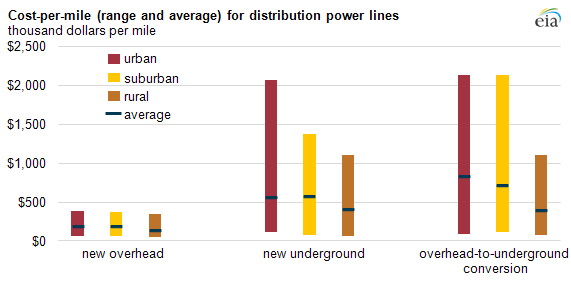
Power outages often spur questions around burying power lines

Extended power outages in the aftermath of a large storm or hurricane often result in discussions around burying local power lines to prevent storm-related outages. Calls for "undergrounding" are common from customers, elected officials, and sometimes state utility commissions. However, undergrounding is costly and the decisions are complex.
The cost of underground power lines is significant—up to five to ten times more than overhead distribution lines. And converting existing overhead lines includes the added cost of dismantling the overhead system. Life cycle costs of underground lines are further increased due to a shorter useful life and higher repair and replacement costs. However, power outages are also costly for our electricity-dependent society—loss of revenue to businesses forced to shut down, costs to families throwing out spoiled food or providing their own power with home generators. And for power outages during extreme weather, such as the recent Mid-Atlantic/Northeast heat wave, extreme discomfort and health consequences are a further concern.
The cost ranges shown for undergrounding represent wide variation around a number of factors, including customer density (urban vs. rural), labor costs, and the type of ground—consider Colorado's granite bedrock, or Florida's high water table. Each construction project is unique and costs from one utility's study may not be easily comparable with another. The chart above shows the cost to the utility, which may or may not flow through to consumers in its entirety. For example a regulated utility may not be allowed to transfer all of the costs to their customers' electricity bills. Or, a municipality might provide funds, land, or materials for the project, avoiding costs transferred directly to consumers. If individuals want their own connections put underground, they are typically responsible for the cost.
The effect of undergrounding on a customer's utility bill depends on the characteristics of each unique project. A few examples show a range of effects:
- A 2010 study assessing undergrounding options requested by the District of Columbia Public Utility Commission noted that burying all overhead equipment would cost $5.8 billion. A local utility official later stated this would add $226 to the average monthly bill over 10 years, or $107 per month for 30 years.
- After a series of storms, North Carolina investigated the costs of undergrounding the state's distribution infrastructure and found it would raise electric rates by over 125%.
- Anaheim, California, decided to completely convert its system for aesthetic reasons. To minimize the impact on customer bills, undergrounding is taking place slowly over a period of 50 years, funded by a 4% surcharge on electric bills.
Despite the cost, underground power lines are often found in urban areas, where the density of the required overhead wire would cause significant obstructions. Also, nearly all new residential and commercial developments have underground utility infrastructure, often required by law for aesthetic reasons. This is often the least expensive type of undergrounding project, as undergrounding costs are reduced when earthmoving equipment is already being used to prepare a building site. Overall, roughly 18% of distribution line mileage is underground, according to the Edison Electric Institute's 2009 update of the Out of Sight, Out of Mind study on underground circuits. On the transmission system, 0.5% of line mileage of 200 kilovolts or higher capacity is underground.
Buried power lines are protected from the wind, ice, and tree damage that are common causes of outages, and so suffer fewer weather or vegetation-related outages. But buried lines are more vulnerable to flooding, and can still fail due to equipment issues or lightning. Problems with underground lines are harder to locate and repair. Underground distribution circuits are typically still linked to aboveground facilities, such as substations and transmission lines, so homes and buildings served by underground infrastructure will not necessarily be spared in the event of system-wide outages from a major storm.
Undergrounding an entire power system is considered cost prohibitive. More commonly, a utility will study undergrounding a few key circuits. This is compared against other options for preventing outages, such as "hardening" the system with protective equipment at vulnerable points, taking a more aggressive approach to vegetation management, improving the system design, or implementing new technology. Smart grid technology, which would allow a utility to pinpoint problems, divert power through other circuits to minimize outages, and optimize crew deployments is another potential approach to reducing outages.
Tags: disruption, distribution, electricity, prices, transmission, weather